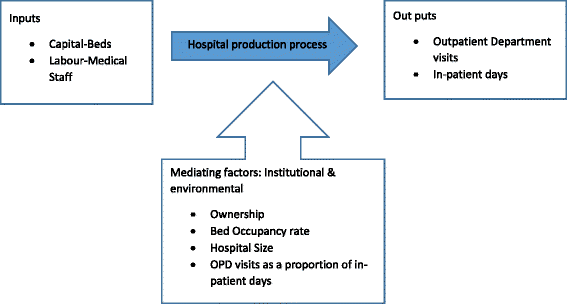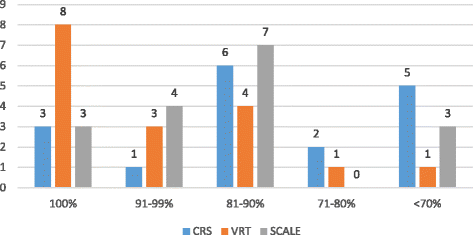How efficient are referral hospitals in Uganda? A data envelopment analysis and tobit regression approach
- PMID: 27391312
- PMCID: PMC4939054
- DOI: 10.1186/s12913-016-1472-9
How efficient are referral hospitals in Uganda? A data envelopment analysis and tobit regression approach
Abstract
Background: Hospitals represent a significant proportion of health expenditures in Uganda, accounting for about 26 % of total health expenditure. Improving the technical efficiency of hospitals in Uganda can result in large savings which can be devoted to expand access to services and improve quality of care. This paper explores the technical efficiency of referral hospitals in Uganda during the 2012/2013 financial year.
Methods: This was a cross sectional study using secondary data. Input and output data were obtained from the Uganda Ministry of Health annual health sector performance report for the period July 1, 2012 to June 30, 2013 for the 14 public sector regional referral and 4 large private not for profit hospitals. We assumed an output-oriented model with Variable Returns to Scale to estimate the efficiency score for each hospital using Data Envelopment Analysis (DEA) with STATA13. Using a Tobit model DEA, efficiency scores were regressed against selected institutional and contextual/environmental factors to estimate their impacts on efficiency.
Results: The average variable returns to scale (Pure) technical efficiency score was 91.4 % and the average scale efficiency score was 87.1 % while the average constant returns to scale technical efficiency score was 79.4 %. Technically inefficient hospitals could have become more efficient by increasing the outpatient department visits by 45,943; and inpatient days by 31,425 without changing the total number of inputs. Alternatively, they would achieve efficiency by for example transferring the excess 216 medical staff and 454 beds to other levels of the health system without changing the total number of outputs. Tobit regression indicates that significant factors in explaining hospital efficiency are: hospital size (p < 0.01); bed occupancy rate (p < 0.01) and outpatient visits as a proportion of inpatient days (p < 0.05).
Conclusions: Hospitals identified at the high and low extremes of efficiency should be investigated further to determine how and why production processes are operating differently at these hospitals. As policy makers gain insight into mechanisms promoting hospital services utilization in hospitals with high efficiency they can develop context-appropriate strategies for supporting hospitals with low efficiency to improve their service and thereby better address unmet needs for hospital services in Uganda.
Keywords: Data envelopment analysis; Hospital efficiency; Technical efficiency; Tobit model; Uganda.
Figures
Similar articles
-
Levels, trends and determinants of technical efficiency of general hospitals in Uganda: data envelopment analysis and Tobit regression analysis.BMC Health Serv Res. 2020 Oct 6;20(1):916. doi: 10.1186/s12913-020-05746-w. BMC Health Serv Res. 2020. PMID: 33023598 Free PMC article.
-
Technical and scale efficiency of public community hospitals in Eritrea: an exploratory study.Health Econ Rev. 2013 Mar 16;3(1):6. doi: 10.1186/2191-1991-3-6. Health Econ Rev. 2013. PMID: 23497525 Free PMC article.
-
Evaluation of performance and impacts of maternal and child health hospital services using Data Envelopment Analysis in Guangxi Zhuang Autonomous Region, China: a comparison study among poverty and non-poverty county level hospitals.Int J Equity Health. 2016 Aug 23;15(1):131. doi: 10.1186/s12939-016-0420-y. Int J Equity Health. 2016. PMID: 27552805 Free PMC article.
-
Technical efficiency of public hospitals in east Africa: a systematic review and meta-analysis.BMC Health Serv Res. 2025 Jan 6;25(1):26. doi: 10.1186/s12913-024-12166-7. BMC Health Serv Res. 2025. PMID: 39762789 Free PMC article.
-
Approach in inputs & outputs selection of Data Envelopment Analysis (DEA) efficiency measurement in hospitals: A systematic review.PLoS One. 2024 Aug 14;19(8):e0293694. doi: 10.1371/journal.pone.0293694. eCollection 2024. PLoS One. 2024. PMID: 39141630 Free PMC article.
Cited by
-
Measuring productivity of healthcare services under environmental constraints: evidence from China.BMC Health Serv Res. 2020 Jul 22;20(1):673. doi: 10.1186/s12913-020-05496-9. BMC Health Serv Res. 2020. PMID: 32698810 Free PMC article.
-
The influence and mechanism of health expenditures on investment of financial assets decisions: A case study of China's economy.Front Public Health. 2022 Nov 10;10:994620. doi: 10.3389/fpubh.2022.994620. eCollection 2022. Front Public Health. 2022. PMID: 36438236 Free PMC article.
-
Analysis of factors influencing technical efficiency of public district hospitals in KwaZulu-Natal province, South Africa.Hum Resour Health. 2022 Nov 22;20(1):80. doi: 10.1186/s12960-022-00777-2. Hum Resour Health. 2022. PMID: 36419126 Free PMC article.
-
Do China rural traditional Chinese medicine hospitals provide efficient healthcare to the people? Empirical study from 2013 to 2018 using data envelopment analysis.PLoS One. 2022 Apr 22;17(4):e0267490. doi: 10.1371/journal.pone.0267490. eCollection 2022. PLoS One. 2022. PMID: 35452498 Free PMC article.
-
The state and significant drivers of health systems efficiency in Africa: A systematic review and meta-analysis.J Glob Health. 2023 Nov 9;13:04131. doi: 10.7189/jogh.13.04131. J Glob Health. 2023. PMID: 37934959 Free PMC article.
References
-
- WHO AFRO. Health financing: A strategy for the African Region. Brazzaville: WHO; 2006.
MeSH terms
LinkOut - more resources
Full Text Sources
Other Literature Sources
Research Materials



